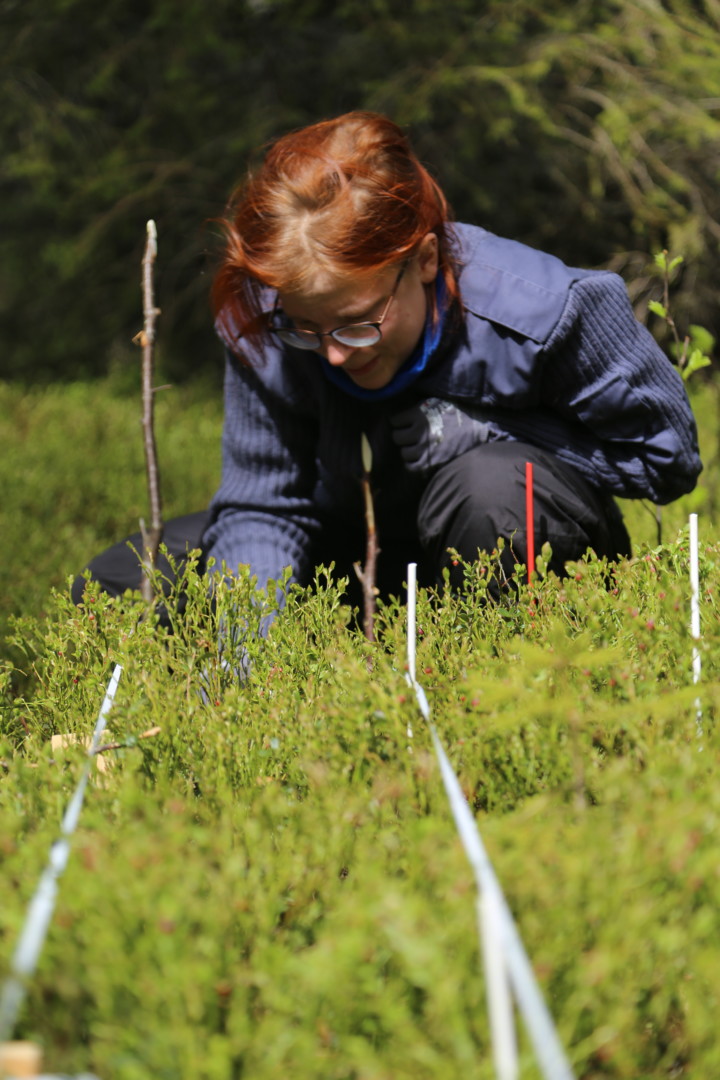
Laura Halvari from Lapland University of Applied Sciences works on a test area focusing on bilberry.
Agro Forestry in Barents Region is carried out by Lapland University of Applied Sciences, Northern Arctic Federal University (in Arkhangelsk, Russia), Norwegian Institute of Bioeconomy Research and Natural Resources Institute Finland.
The forests produce not only timber. Non-timber forest products (NTFP) is a widely known concept by which is generally meant berries, mushrooms growing on the ground and on trees, resins.. various kinds of natural products that grow in forests.
While a tree grows for maybe decades before it can be eco-efficiently used for timber products, many of the non-timber forests species grow and are ready for utilization in the meantime. Some of them (e.g. berries) can be picked every year. They can give extra income.
The availability of the products is insecure. You never know when and where they grow. How good is the harvest this year? Under these circumstances it is quite understandable that the SMEs are hesitant to invest into, for example processing facilities. But maybe there are methods how humans can enhance and control their growth? The project Agroforestry in Barents Region works on these central challenges and questions.
The demand for natural products is on the increase
Internationally, the interest for natural products has been growing during the recent years among consumers and the industries. It is easy to understand that forest owners are interested in utilizing the situation and their resources. Many of the NTFP that are on the focus of the project, are already utilized on the markets, but the availability is one central bottleneck which makes the refining industries not so willing to invest on, for example, machines.
The objective of the project is to combine agricultural and forestry technologies aiming to create profitable, healthy, ecologically sound and sustainable land-use systems for improved availability of NTFP raw materials in Barents region. Current, passive use of forest as a source of Non-Timber Forest Products is not agroforestry. Agroforestry is always governed, target – oriented concept in which investments are used or alternative costs are accepted in order to achieve the most profitable output.
These experts know the forests
One interesting part of the project is piloting of agroforestry practices In the task division in the project, the Norwegian Institute of Bioeconomy Research is responsible for it. The participating organisations all are experienced in field testing, and in this project they combine their strengths in testing. It is then also possible to compare results in differents testing areas and in different habitats – in differents countries.
Bilberry is one of the species in the project. It is a desired berry because of its taste and healthiness, but the availability varies a lot. It is not exceptional to see 3- 4 fold differences in the amount of bilberries in subsequent years. The growth of bilberry and methods to control it is tested in the project in Finland, Norway and Russia.

Chaga mushroom (Inonotus obliquus) groving on a birch tree. Photo: Marja Keskitalo, Natural Resources Institute Finland (LUKE)
Not all forests and trees are suitable for sustainable timber production. Where the circumstances are appropriate, the production of chaga mushroom may be one alternative. Chaga is a success among health products. Natural Resources Institute Finland especially has promoted knowledge on Chaga, and it is one species that the project has involved in their field tests.
Chaga mushroom – not the most beautiful, but one of the trendiest products
Domestic use of non-timber forest products has been a strong tradition in the Kolarctic region, but it has decreased. Especially Arkhangelsk region has traditionally been in the forefront of expertise in utilizing natural products in food and medicine production. In Arkhangelsk, Northern Arctic Federal University is in the project – among other tasks – responsible for mapping of traditional use of non-timber products at the region, and practises with potential to be developed.


